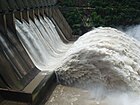Dam
| Subject classification: this is an engineering resource. |
A dam is a large wall or barrier that obstructs or stop the flow of water, forming a reservoir or a lake.[1] Most dams have a section called a spillway or weir over which, or through which, water flows, either sometimes or always. Dams generally serve the primary purpose of retaining water. The tallest dam in the world is the 300 meter high Nurek Dam in Tajikistan.
Some of the first dams were built in Mesopotamia up to 7,000 years ago. Modern dams are built with arched walls of steel rod-reinforced concrete. The arched wall is a very strong shape which helps the wall to withstand the huge weight of the water.
Reasons for building dams
[edit | edit source]There are a number of reasons that people build dams. Some countries build dams to control the flow of water in the downstream river systems, and prevent flooding. Other countries build dams to generate electricity using hydroelectric turbine generators. Other countries use dams to store water for use in irrigation (for farming).




